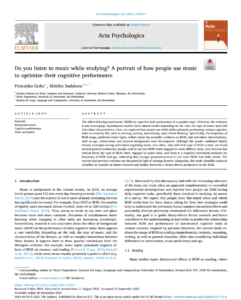
Many of us use background music or sounds to study. I am using some right now! The question of whether it improves productivity is a difficult question to answer but there are some emerging guidelines to help you pick background sounds. Reading time ~ 7 minutes.
I generally encourage people to develop routines and rituals associated with their work. Often this is focused on disrupting patterns of procrastination.
Work rituals can include a range of behavioural and psychological components. Behavioural components include things like setting up one’s desk, making a cup of tea, turning on and adjusting lamps, writing a to-do list, breathing techniques. Psychological components include things like meditation, affirmations and self-reflection.
The goal of a work ritual is getting you in the right headspace and physical space to make progress on your tasks.
A key part of my work ritual is background music (BGM).
The research on BGM when studying/working and its impacts on performance is a bit all over the place:
In their 2021 quick review and preference study Goltz and Sadakata found that: 
- the findings are mixed as to whether BGM improves reading, memory, critical thinking, reasoning, writing and attention. Sometimes it does. Sometimes it doesn’t 🤦🏽♂️
- when people are doing simple tasks, the choice of BGM is less important. As long as the person likes what they are listening to, it is often helpful.
- as task difficulty increases, people are less likely to find background sounds helpful and if they do they generally err towards classical, calming and non-vocal music. Basically they seek out BGM that doesn’t distract or over-stimulate them and doesn’t impair concentration.
- there is a high degree of individual difference in what people like and what seems to work for them – what works for you might not work for me. This means there is value to experimenting with different things to see what you like/ what works.
- BGM likely provides benefits (when it does) via a number of mechanisms:
- It improves our mood
- It helps modulate our arousal level – calm us when needed, ramp us up when needed
- Prevents distraction from other sources
- Limits mind wandering
- Prevents boredom, particularly in repetitive simple tasks
- It is generally better to choose BGM that doesn’t stress our working memory (that is needed for the task). That is, it shouldn’t be super engaging or complex or change a lot.
What works for me 🎧
For me, I’ve found two types of BGM that help me:
Brain.fm – I pay for a subscription to this and use it for study, sometimes to relax and sometimes on walks. Brain.fm combines pleasant but non-distracting non-vocal music with rhythmic pulses that supposedly elicit functional brainwave states.
Mynoise – I donate a small amount to the site to access their full catalogue. I am listening to one of their interactive soundscapes as I write this post. Mynoise use super high quality real-world recordings and audio engineering to create “beautiful noises to mask the noises you don’t want to hear’. In a tweet to me they once wrote “A lot of attention is put in creating tracks that feel repetitive, so that you don’t get too excited, but not repetitive enough to get bored. It took years of practise to understand the right alchemy.”
I use both these primarily so that I can work for extended periods without getting too distracted.
I rarely study with actual music. I have and love my music streaming service and I have been known to crank Meshuggah when I have lots of emails to process, but outside of that I tend to find the music I like too distracting to study do.
Other options
I’m mindful of a number of other BGM options, some of which I intend to explore in the future.
Endel – looks a bit similar to Brain.fm
Resident advisor – mix of the day – for those that like electronic music
YouTube – you can search for a tonne of different types of background music
Nature Track – a program from ABC Radio National that provides soundscapes from the Australian wilderness
I’m also aware that sometimes people like to set up to study in locations that have pleasant background sounds such as a cafe or library.
What about background people instead of music?
Rather than BGM, some people like to study in the presence of others. In the ADHD community it is sometimes called body doubling. Another term is an ‘accountability partner’. Focusmate is an example of leveraging technology to achieve this outcome for people working online/remotely. I plan on trying this out one day. Let me know if you want to join me for a Focusmate experiment at some point.
Note that this is different from a study group where the goal is leveraging the interactions (e.g. testing each other, brainstorming). A body double is someone who is present but both of you are focused independently on your respective tasks. You may connect briefly at the beginning and end (or at points along the way) but you are still working silently the bulk of the time. We tried this a little bit last year with Shut Up and Study groups. Demand for these was fairly low so we scrapped them, but you can easily create your own sessions with a willing partner/peer, Zoom/Teams and a calendar.
Key takeaway
As we build routines and rituals for better productivity, it is worth paying attention to what is happening in the background when we work. BGM is a great starting point and a central part of my routine and the routine of others.
What background music or sounds do you use whilst studying? Share them in the comments below or find me on Twitter. By sharing you might help another student find the perfect background sound.

